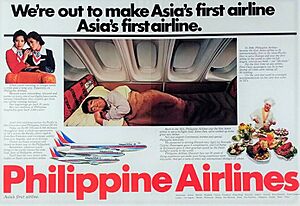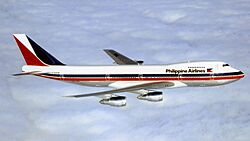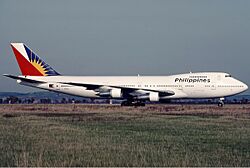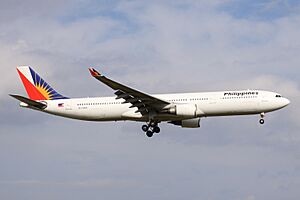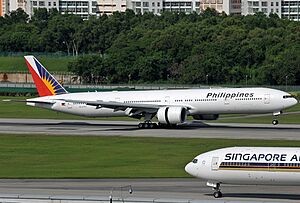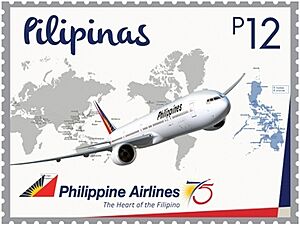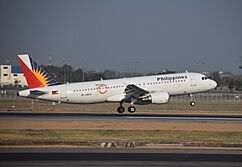History of Philippine Airlines facts for kids
Philippine Airlines (PAL) is the main airline of the Philippines. It's like the country's official airline! PAL flies from its main hub at Ninoy Aquino International Airport. It's super old, being the oldest airline in Asia that still uses its original name. It started way back in 1941.
Contents
- How it All Started (1930s-1950s)
- Growing Bigger and Modern (1960s-1980s)
- New Owners and More Growth (1990s)
- Financial Challenges (1997-1999)
- Getting Back on Track (2000s)
- After Financial Recovery (2008-2011)
- San Miguel Corporation Takes Over (2012-2014)
- Lucio Tan Returns and Continued Growth (2014-2020)
- COVID-19 Pandemic (2020-2022)
- After the Pandemic (2022-Present)
How it All Started (1930s-1950s)
Early Days: Philippine Aerial Taxi Company
A company called Philippine Aerial Taxi Company (PATCO) was created on December 3, 1930. It began flying on March 18, 1931, with a trip from Manila to Iloilo. They also had flights to Baguio and Paracale.
Philippine Air Lines is Born
On February 26, 1941, a new company, Philippine Air Lines, Inc., was officially started by a group of business leaders. One of the main people was Andrés Soriano Sr., a big name in Philippine industry. He became the airline's general manager. Soriano and former senator Ramón J. Fernández bought PATCO and changed its name to Philippine Air Lines (PAL).
PAL's very first flight was on March 15, 1941. They used a single Beechcraft Model 18 plane. It flew daily between Manila (from Nielson Field) and Baguio. The plane carried two pilots and five passengers, who were the airline's founders. In September 1941, the government invested in PAL, making it a national airline.
PAL stopped flying during World War II (from late 1941 to 1945 in the Philippines). Their planes were even used to help the military!
On February 15, 1946, PAL started flying again after five years. They had five Douglas DC-3 planes and flew to 15 places in the Philippines. PAL returned to its original home at Nielson Field in Makati. PAL helped fix up and modernize the airport, making it the main entry point for air travelers into the Philippines.

A cool fact: On July 31, 1946, PAL became the first Asian airline to fly across the Pacific Ocean! A special Douglas DC-4 plane flew 40 American soldiers to Oakland, California. It made stops in places like Guam and Honolulu. Regular flights between Manila and San Francisco began in December 1946. Around this time, PAL was officially named the country's flag carrier.
PAL started flying to Europe in 1947. By 1948, PAL had taken over other airlines in the Philippines. PAL also moved its main operations to a new international airport at Nichols Field in Pasay.
In 1951, PAL even helped Japan Airlines get started by leasing them a plane! In March 1954, the Philippine government stopped all flights to Europe, Japan, and the United States for a while. Five years later, they started again. PAL also began services to Hong Kong, Bangkok, and Taipei using Convair 340 planes, which were later replaced by Vickers Viscount 784 planes. This brought PAL into the age of turboprop planes, which are faster than older propeller planes.
Growing Bigger and Modern (1960s-1980s)
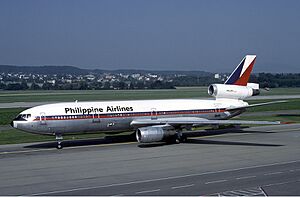
In the 1960s, PAL entered the jet age! This meant they started using jet planes. They first used a Boeing 707, then switched to Douglas DC-8 aircraft. These jets were used for long international flights to Europe and the United States.
PAL's domestic flights (flights within the Philippines) grew to 72 locations. In May 1964, some of the smaller rural flights were stopped. Two years later, PAL started its first jet services to Cebu, Bacolod, and Davao using BAC1-11 jets. These jets also flew to Bali, Indonesia, starting in 1969.
PAL also became a private company again when Benigno Toda Jr., the chairman, bought most of the airline's shares.
In 1972, after Ferdinand Marcos Sr. became president again, he made a rule called the "one-airline policy." This meant PAL was the only airline allowed to operate, and it took over other airlines like Air Manila and Filipinas Orient Airways. On March 10, 1973, PAL was again officially named the national flag carrier.
PAL continued to grow, getting its first McDonnell Douglas DC-10 in July 1974. This plane was used for the Manila to San Francisco route, with a stop in Honolulu. Three years later, the Philippine government bought back most of PAL's shares, making it a national airline once more. In 1979, the Boeing 727, the Boeing 747-200B, and the Airbus A300B4 (nicknamed the Love Bus) joined PAL's fleet.
Between 1979 and 1981, PAL built many big facilities near the airport, like a technical center and an aviation school. PAL was also the first airline to win an award for its amazing food served on flights! On January 4, 1980, PAL introduced its Boeing 747-200, called the Jumbo Jet, for flights to Honolulu and San Francisco. PAL was also the first airline since the 1950s to offer fully flat beds on a plane. These 14 "Skybeds" were in the first-class section of the 747s and were super comfy!
On April 2, 1982, a PAL Boeing 747-200B was the first plane to land at the new Terminal 1 of Manila International Airport. PAL also improved its cargo services by building a special cargo terminal. Flights to Paris and Zürich began in November 1982.
After a change in government in 1986, Dante G. Santos became PAL president. He started a big plan to modernize the domestic fleet. PAL got new planes like the Short 360 (nicknamed The Sunriser), the Fokker 50, and the Boeing 737-300. International flights also expanded in 1987, with new service to Riyadh.
In October 1988, PAL opened a new domestic terminal, PAL Domestic Terminal 2. This terminal served passengers flying to Cebu and Davao, and later to General Santos and Puerto Princesa. This helped make travel more convenient for passengers.
New Owners and More Growth (1990s)
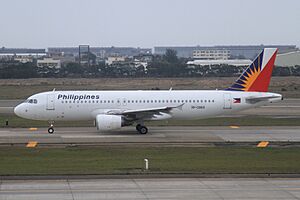
PAL became a private company again in January 1992. In November 1993, PAL got its first Boeing 747-400. This huge plane, one of the world's largest, became a main aircraft for PAL's flights across the Pacific Ocean. A new flight between Manila and Osaka started in 1994, bringing PAL's international network to 34 locations.
In January 1995, Lucio C. Tan became the new chairman and CEO of PAL. In April 1996, PAL started a huge US$4 billion plan to modernize its planes. They ordered 36 new, advanced aircraft from Airbus and Boeing. The goal was to have the youngest fleet of planes in Asia and expand their flight network. These orders included eight Boeing 747-400s, four Airbus A340-300s, two Airbus A340-200s, eight Airbus A330-300s, and twelve Airbus A320-200s.
Financial Challenges (1997-1999)
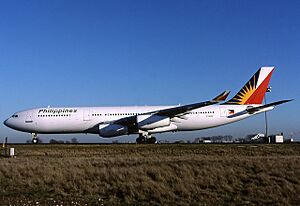
In 1997, PAL changed its slogan to "Asia's Sunniest." They also started flights to New York City. However, buying too many planes and having flights that weren't making money caused financial problems. The 1997 Asian financial crisis hit the airline industry hard in 1998.
By March 31, 1999, PAL had to close its hub at Mactan–Cebu International Airport. There were also many layoffs (people losing their jobs). Disputes between the airline's owners and the employee union led to PAL completely stopping operations on September 23, 1998. Cathay Pacific temporarily took over PAL's flights during this 14-day shutdown.
PAL started flying again on October 7, 1998, after an agreement was reached. They resumed flights to 15 domestic locations. International flights to Los Angeles and San Francisco restarted on October 29, with other international services following later. PAL slowly expanded its network again.
In 1999, PAL moved its operations to the new Terminal 2 of Ninoy Aquino International Airport. This terminal was called the Centennial Terminal to celebrate 100 years of Philippine independence. This allowed all of PAL's flights to operate from one terminal for the first time.
Getting Back on Track (2000s)
In 2000, PAL finally started making a profit again after six years of big losses! On September 1, 2000, PAL handed over its maintenance and engineering division to a company called Lufthansa Technik Philippines. This was part of its plan to recover financially. In August of the same year, PAL launched an email booking system. In 2001, PAL continued to make a profit. They also brought back flights to places like Bangkok, Taipei, Sydney, and Vancouver, and started new flights to Shanghai and Melbourne.
Like many airlines, PAL was affected by the September 11 attacks in 2001. In 2003, PAL was reorganized again.
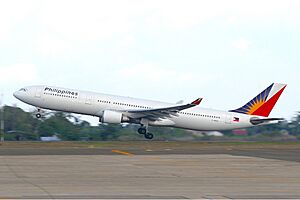
The Mabuhay Miles frequent flyer program was launched in 2002. This program lets passengers earn points for flying, which they can use for free flights or upgrades. An online system for checking arrivals and departures and a new booking system were launched in 2003. In December, PAL also got a fifth Boeing 747-400.
In 2004, PAL started flights to Las Vegas. They also returned to Laoag and began flights to Macau. PAL also made agreements with Air France and KLM Royal Dutch Airlines to share flights to Paris and Amsterdam. PAL continued to update its planes, getting two new Airbus A320-214s and launching electronic tickets.
In March 2005, PAL started flights to Nagoya and brought back scheduled flights to Beijing after 15 years. To compete with other airlines, PAL ordered and leased up to 18 new Airbus A319-112s and A320-214s in December 2005.
The first new Airbus A319-112s arrived on October 20, 2006. These planes were the first in PAL's history to offer in-flight entertainment where you could choose what to watch! In December, PAL ordered two Boeing 777-300ER aircraft, which are very large planes, to be delivered in 2009. These new planes replaced older orders for 747-400s.
Philippine Airlines was recognized as "Airline Turnaround of the Year" in 2006 and 2007 for successfully improving its operations and making profits.
After Financial Recovery (2008-2011)
On October 4, 2007, PAL was officially released from financial supervision after making a huge profit. The airline immediately planned to attract investments from other countries. PAL continued its big expansion plans, launching a regional airline called PAL Express on April 10, 2008. PAL Express started flying on May 5, with flights between Manila and Malay.
However, international safety concerns about the Philippine aviation industry made it hard for PAL to expand. The United States lowered the Philippines' aviation safety rating in January 2008. This stopped PAL from adding more flights to the United States or changing the types of planes it used there. Also, on March 30, 2010, airlines from the Philippines were put on an EU aviation blacklist, which banned PAL from flying to Europe. (Good news: PAL was removed from this blacklist in 2013!)
Despite these challenges, PAL continued to expand in Asia. They brought back flights to Riyadh and added flights to Brisbane and Delhi. However, these new routes didn't make enough money and were later cancelled.
PAL also went ahead with its plan to get widebody planes, receiving its first two Boeing 777-300ER aircraft in late 2009 and early 2010. These planes have 370 seats and offer in-flight entertainment in all classes.
Employee Challenges
In July 2010, 25 of PAL's pilots resigned without telling the airline. PAL tried to take legal action against them. In the same month, PAL announced it would be outsourcing some jobs, which meant some employees would lose their jobs. This led to disagreements with flight attendants and other staff, and a strike happened on October 27, 2010. On November 12, 2010, the government approved the layoff of 2600 PAL employees.
San Miguel Corporation Takes Over (2012-2014)
On April 4, 2012, a big company called San Miguel Corporation bought a 49% share in Philippine Airlines for $500 million. San Miguel wanted to help modernize PAL, update its planes, and make it more competitive in Asia. San Miguel's president, Ramon Ang, also said they wanted PAL to join a global airline group.
PAL's first big move under San Miguel was a huge $7 billion order for 54 Airbus planes on August 28, 2012. These included 44 Airbus A321s and 10 Airbus A330-300s. The A321s were for domestic and regional flights, while the A330-300s were for flights to Australia, the Middle East, and some European routes. PAL received its first planes from this order in 2013.
Under San Miguel, PAL started expanding its flight network, adding new routes and bringing back old ones. In 2013, the airline announced its return to Abu Dhabi, Dammam, and Riyadh. They also launched new routes to Brisbane and Perth, as well as Doha and Jeddah.
In 2013, PAL was removed from the EU aviation blacklist, which was great news! The airline immediately announced its plans for Europe. PAL then started flights between Manila and Heathrow in November 2013, its first European destination in 15 years. They also expanded their US service with flights from Manila to New York via Vancouver.
San Miguel also wanted PAL to invest in other aviation companies. In 2013, PAL partnered with a Cambodian company to launch a new airline called Cambodia Airlines.
On August 30, 2012, PAL president Ramon Ang announced plans to build a second international airport for Metro Manila. He felt the current airport was too crowded. However, this project was later postponed due to government rules.
On September 8, 2014, San Miguel announced it would sell its 49% share in PAL back to Dr. Lucio Tan's group. The deal was completed on September 15, 2014. On October 15, 2014, Ramon Ang officially stepped down as president.
Lucio Tan Returns and Continued Growth (2014-2020)
On October 23, 2014, Jaime Bautista was appointed as the new president and COO of Philippine Airlines. Under his leadership, PAL decided to delay getting some new planes to avoid having too many. They also planned to replace their older A340 planes with newer ones like the Airbus A350 XWB or Boeing 787 Dreamliner. PAL also leased more 777s for its growing long-haul flights.
In January 2015, Philippine Airlines became the official airline for Pope Francis during his trip to the Philippines. The plane he used was even called "Shepherd One"!
In March 2015, PAL resumed flights to New York City via John F. Kennedy International Airport. They also expanded to the Oceania region, starting flights to Auckland, New Zealand, and Port Moresby in Papua New Guinea. PAL's global expansion helped it become one of the most profitable airlines in Southeast Asia.
In June 2015, Philippine Airlines renewed its partnership with Lufthansa Technik Philippines for aircraft maintenance.
In 2016, Philippine Airlines announced new flights between Manila and Doha, Manila and Kuwait City, and Cebu City to Los Angeles.
In April 2016, for its 75th anniversary, PAL launched a new campaign called The Heart of the Filipino. They released new advertisements with famous singers and the Miss Universe 2015 winner, Pia Wurtzbach. The airline also released a new pre-flight safety demonstration video in February 2017, showing beautiful tourist spots in the Philippines.
PAL continued to expand its international and domestic flights. The airline started flying to Nanning and Sapporo, and non-stop flights to Brisbane, New York City, Perth, and Toronto. They also launched new flights to Clark, making Clark International Airport its second hub. However, some flights to Kuwait, Jeddah, and Darwin were stopped due to low demand.
PAL also got new aircraft, including its 9th and 10th Boeing 777-300ER in 2017. They also acquired six new Airbus A350-900 planes, which are used for long-haul international flights. The airline also got Airbus A321neo and Bombardier Q400 planes for regional and domestic flights. PAL retired its Airbus A340 aircraft, being the last airline in Asia to use them.
Thanks to improvements in its planes, facilities, and services, PAL received a four-star rating from Skytrax in December 2017. It was also named the Most Improved Airline of 2019 by AirlineRatings.com.
On January 29, 2019, All Nippon Airways bought a 9.5% share in PAL's holding company for US$95 million.
On February 20, 2019, Philippine Airlines received its fifth Airbus A350, which had the famous "Love Bus" symbol. This celebrated 40 years of partnership with the aircraft maker, Airbus.
On July 29, 2019, Gilbert Santa Maria was appointed as the new president and COO of Philippine Airlines.
COVID-19 Pandemic (2020-2022)
In February 2020, Philippine Airlines had to lay off 300 workers because of financial losses caused by the COVID-19 pandemic. On March 17, 2020, it stopped its domestic flights, and then its international flights on March 26, due to a lockdown in the Philippines. Limited flights started again in June 2020, but were stopped again in August. By the end of 2020, PAL reported a huge financial loss.
On March 15, 2021, Philippine Airlines celebrated its 80th anniversary.
Because of mounting debts, the airline filed for bankruptcy protection in a New York court on September 4, 2021. They cancelled over 80,000 flights and let go of 2,300 employees. Two days later, the airline announced it would return 22 planes to the companies they leased them from, reducing its fleet size. PAL managed to finish its financial restructuring very quickly, in just three months. By the end of 2021, it was making a profit again!
After the Pandemic (2022-Present)
On January 31, 2022, Captain Stanley K. Ng became the new president and COO of Philippine Airlines. He is the first pilot to be president of the airline since the 1960s. In 2022, the airline reported a huge profit as travel restrictions eased around the world.
New destinations and resumed flights were also announced. On December 16, 2022, PAL returned to Baguio, which was the airline's very first destination! However, this route was later stopped in 2024 because not enough people were flying on it. In January 2023, as China lifted its travel restrictions, PAL resumed flights to Xiamen and Guangzhou, and then to Shanghai and Beijing a month later.
On June 16, 2023, PAL moved all of its international flights to Terminal 1 of Ninoy Aquino International Airport. This made space for Terminal 2 to handle only domestic flights.
On April 9, 2024, PAL's new flight attendant uniform was voted the best in the world in a poll! It has a flag blue suit with a floral scarf for women and a similar style for men. It shows a mix of professional style, elegance, and Philippine culture.


